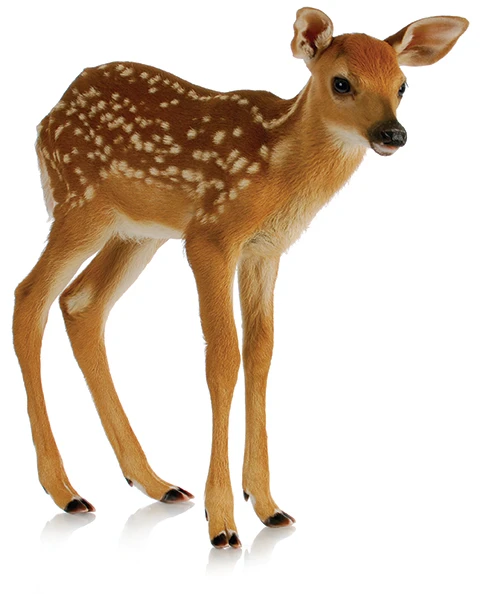
 Got landscape design jobs? Terrific. Got deer? Oh, no.
Got landscape design jobs? Terrific. Got deer? Oh, no.
All solutions come down to three approaches. There are two broad categories of fencing: non-electric, which emphasizes physical exclusion, and electric, which trains deer to stay away. There is a broad category of repellents that rely on sounds, sights, scents and tastes. Finally, there are plant selections that rank low on the preference list of the four-footed feeding machine in question.
It would be nice for us if any one of these strategies alone would solve the problem, but most properties require multiple approaches.
Fences.
While they have the most visible impact on a landscape plan, fences can’t be counted out because they are so effective. Assuming that local zoning permits fences, which fence is right for your client’s property?
“A 10-foot fence is generally considered deer-proof,” says Scott Williams, Ph.D., a wildlife biologist at the Connecticut Agricultural Experiment Station in New Haven, Conn.
On a property surrounded by woods, a 10-foot mesh fence is relatively invisible (though it has other issues, as we’ll see later). In a treeless new home development, however, such a fence would probably not pass muster. Small wonder, then, that shorter versions have been developed.
Deer don’t necessarily want to jump fences, adds Scott Williams. “Deer are much more likely to go under a fence than over,” he says.
Fawns are particularly likely to try an “under the fence” strategy. If they are successful, they may be followed by adults. This is why the bottom of the fence is as important as the top.
In Felton, Calif., Renee’s Garden Seeds found a fence design for the company’s trial gardens many years ago that owner Renee Shepherd calls, “Less obtrusive than most.”
She says they have fenced a quarter-acre of vegetable beds and 15 fruit trees “with 100 percent success for the past 12 years.” The fence is not electrified and they use no sprays.
Indeed, this design relies on a widely recommended principle of deer fence design – which is to keep them guessing. They have poor close-up vision and if they can’t judge the height of the fence, they are unlikely to chance a jump.
Some very successful designs are only 4 feet to 7 feet high. For example, the double-row fence is only 4 to 5 feet tall. The two rows are placed about five feet apart. The theory is that deer won’t jump both high and broad in the same jump. Yet other fences, typically 5 feet tall, rely on electric shocks to “train” deer to stay away. Some even use lures to draw deer to the electrified posts and then deliver a nasty taste and shock to give them a message.
How much territory should a fence encompass? According to Neil Soderstrom, Wingdale, N.Y. author of “Deer-Resistant Landscaping,” “If you live in an area with coyotes and foxes and they become totally excluded, the rodent population inside the fence may explode.”
Considering that white-footed mice and many other small mammals transmit disease to ticks during spring and summer, this is worth noting. Tick-borne diseases are a major concern in many areas of the U.S.
 Soderstrom has used two approaches successfully, he says. Both of them are easier on the eye than a 10-foot perimeter fence.
Soderstrom has used two approaches successfully, he says. Both of them are easier on the eye than a 10-foot perimeter fence.
His first is to create thick borders of powerfully aromatic plants to confuse the deer with scent. “Deer aren’t very tall and if there’s a visual screen they are less likely to jump inside,” he says.
His second approach, and he says most effective fence design, is one he calls the Soderstrom Arched Deer Fence, (pictured on the right.) He offers complete instructions in his book.
Repellents.
“The key to non-fence solutions is to keep changing things,” says Greg Van Steinburgh, program director for the Deertech service offered by SavATree in Bedford Hills, N.Y. “Deer startle quickly but they also become quickly accustomed.”
The firm uses a three-pronged strategy including permanent installation of ultrasonic devices that confuse deer hearing and makes them less likely to lower their heads to feed.
“We also visit client properties monthly, monitor for damage, fine tune the deterrents and vary the sprays according to season,” Van Steinburgh says, adding that multiple strategies maximizes results.
Which brings us back to the strategy where most of us begin. In our multi-pronged strategies, where does plant selection fit?
As pointed out by Soderstrom in his book, deer diet varies by region, gender and time of year. Furthermore, the range of foods they’ll at least nibble increases as population density goes up or starvation conditions occur.
Plants.
First, assume that anything in the legume family will be appetizing for deer. Legumes provide protein. Lupines, peas, beans, field peas, alfalfa, clover and peanuts all make the list.
Second, ferns and ornamental grasses are generally off the menu. Even lawn grasses are not a favorite, though deer happily nibble the clover we put in lawn mixes.
Third, members of the onion family – aka the alliums – hold no appeal. This leaves us with a nice array of ornamental bulbs, most flowering in spring and early summer, as well as some safe vegetable crops. Alliums likewise have little appeal for other wildlife.
Fourth, the enormous mint family is not part of a deer's cuisine. The list of possibilities is truly long, including artemesia, calamint, catmint, catnip, hyssop, lamb’s ear, lamium, lavender, lemon balm or melissa, monarda, mountain-mint, Russian sage, obedient plant, rosemary, sages, salvias, teucrium or germander, thyme and winter savory.
Fifth, many members of the poppy family are deer-resistant, including not only the flowers of that name but the dicentra, bleeding hearts, celandine, corydalis and sanguinaria, as well.
Finally, a number of ericaceous plants are deer-resistant, including heaths and heathers, as well as leucothoe, aka fetterbush or dog-hobble.
Given the lack of effective population management, it may be a long time before numbers decline.
In the meantime, a great deal has been learned about how to keep properties off the menu at the Deer Café.
The author is a garden writer, speaker and landscape designer based in Old Saybrook, Conn.
For more on deer deterrents, visit:
- Instructions for Renee’s Garden fence: bit.ly/reneedeer
- North Carolina Wildlife Resources Commission: bit.ly/excludedeer
- The New Jersey Agricultural Experiment Station: bit.ly/njdeer
Get curated news on YOUR industry.
Enter your email to receive our newsletters.

Explore the November 2014 Issue
Check out more from this issue and find your next story to read.
Latest from Lawn & Landscape
- Sgro named Yanmar Compact Equipment's North American president
- Aphix acquires Curb Appeal Landscaping in Birmingham
- Project EverGreen helps revitalize Milan Park in Detroit
- Trex Company wins Product of the Year, Judges’ Choice Winner at Environment+Energy Leader Awards
- General Equipment & Supplies in Fargo adds Takeuchi equipment
- Mariani Premier Group acquires Hazeltine Nurseries
- EnP Investments adds Mark McCarel as Northeast territory sales manager
- Our April issue is now live





